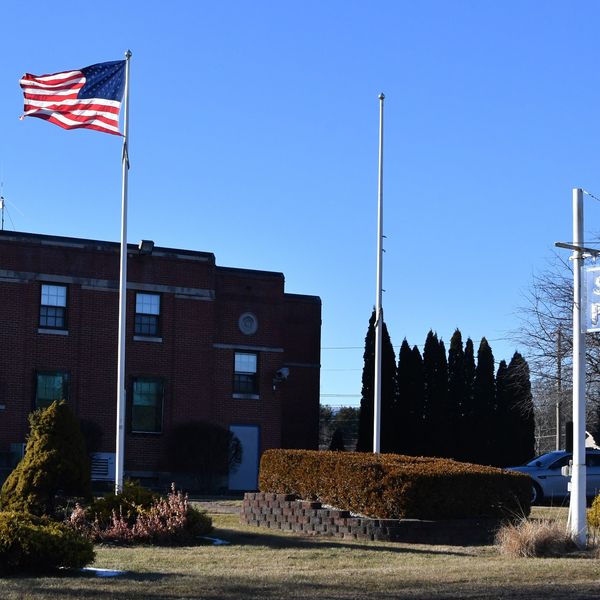
Latest News
Barbed wire at Birkenau.
Natalia Zukerman
Jan. 27 marked the 80th anniversary of the liberation of Auschwitz-Birkenau. I traveled to Poland as part of a delegation for the commemoration and spent a few days before the event with my father and sister learning, remembering and gathering information.
My dad’s parents, Miriam and Yehuda, of blessed memory, were deported to Auschwitz -Birkenau from the Lódz Ghetto. They both had families that perished and met each other after the camp was liberated.

I put my feet in the train tracks where they would have arrived, ran my hands across the walls of the horrible gas chambers, the broken wood of the crowded bunks, gathered dirt in my shoes where they would have walked, and made sure to touch the trunks of the trees along the path—innocent witnesses.
My father’s parents survived. How did they do it? Miriam was quickly sent to a work camp on the Czech border, and Yehuda played violin in the Auschwitz orchestra (aka the Death Orchestra). Music saved him. A million miracles saved them both.
Many members of our extended family did not survive.

Cuikerman was the original Polish spelling of our name. We poured over page after page of our name in the Book of Names. I can’t explain it, but as I read the names—aloud and quietly—I felt some of their spirits finally release.
Innocent witnesses.
I never wanted to come to Auschwitz-Birkenau. I grew up in the shadow of the Holocaust. It was part of our dark story. From the time I was very little, I saw all the images, watched the movies, read the books. I’ve had nightmares my whole life. I remember the tattoo on my grandmother’s forearm. This was enough.
But until you stand in the field the size of a city and look out at the expanse of crematoria, gas chambers, bunkers, the enormity and scale is just a story, words on a page. Now I have metabolized it in a different way. Now it is part of my DNA on a deeper level. Now I am changed.

On Holocaust Remembrance Day, world leaders from fifty countries—including King Charles, Volodymyr Zelenskyy, Emmanuel Macron, Justin Trudeau and so many more— gathered with survivors and their families, musicians, friends and patrons of the organization in an enormous tent at the entrance to Birkenau. A freight train stood in front of the main gate. The car, from Germany, honors the 420,000 Hungarian Jews deported in 1944. Its conservation was funded by Frank Lowy, whose father, Hugo, was killed in the camp.
It radiated with horror in almost theatrical lighting, its now silenced whistle audible in the memories of all who gathered.
I listened to survivor after survivor speak. I watched as each world leader lit candles in remembrance. I said Kaddish (the Jewish prayer for the dead) with the several thousand people present.
But I only heard one person, 99-year-old Polish-born Swedish-Jewish doctor Leon Weintraub, utter any words that made sense to me, to my very fragile and shaken heart. He became a doctor after the war and told the group gathered the one absolute truth: there is only one race—the human race. He talked about the fact that under the skin, we are the same, words that were beyond powerful. In the very place where the most evil “experiments” were conducted to prove the supremacy of the Aryan race, this man stood there in all his beautiful bravery and told the truth. He was able, for a moment, to remove a hierarchy of care and replace it with an expansive, human appeal. He brought the memory of all the people killed, not just the Jews when he said, “be sensitive to all manifestations of intolerance and dislike of those who differ in terms of skin color, religion or sexual orientation.” He widened the conversation, lest we also forget the Romani, queer, disabled, dissidents and more that were also victims of the Nazis. Lest we forget the lesson of Gandhi when he said, “intolerance itself is a form of violence.”
Weintraub ended by saying, “allowing the memory of millions of innocent victims to fade would be equivalent to robbing them of their lives a second time.”

There are multiple genocides on planet earth right now. There are humans in actual concentration camps as I write this. There are whole populations being murdered.
After this experience, more than ever, I vow to speak the truth as loudly and as often as I can.
Speaking up, questioning and protesting is not only not antisemitism, it defines the core principles of what it means to be Jewish.
A beautiful Jewish human named Albert Einstein said, “Our task must be to free ourselves by widening our circle of compassion to embrace all living creatures and the whole of nature and its beauty.”
This must and will be my task. Nothing else makes any sense.

Keep ReadingShow less
Dina La Fonte
Photo by Dina La Fonte
The “sober curious” movement has gained momentum in recent years, encouraging individuals to explore life without alcohol—whether for health reasons, personal growth, or simple curiosity. Dina La Fonte, a certified recovery coach, is the Senior Business Affairs Associate at Mountainside, an alcohol and drug addiction treatment center with a holistic approach to wellness that has several locations, including the one in Canaan, Connecticut. With nearly five years of sobriety, La Fonte blends professional expertise with lived experience, making her a powerful advocate for recovery.
Like many, La Fonte’s path to recovery was not just about removing alcohol; it was about rediscovering herself. “Once you get sober from a substance, whether it’s alcohol, drugs, gambling or what have you, emotional aspects of change come into place,” she explained. “It’s not a hard stop; it’s a continued process of integration and struggle.” Her own journey has led her to a career in recovery coaching, allowing her to help others find their own path.
“What I love about my work at Mountainside is that it allows me to be who I am without forcing me into a mold,” she said. “In recovery, we identify our authentic voice, establish boundaries, and clarify what we truly want.”
La Fonte explained that the rise of the “sober curious” movement may reflect a cultural shift in how we approach alcohol and self-care. La Fonte attributes this change to open conversations that break down stigma. “Even five or six years ago, admitting you had a problem came with embarrassment,” she said. “Now, the more we discuss it, the more people realize they’re not alone.” This newfound openness has perhaps made it easier for some individuals to explore sobriety and even do so without the pressure of a lifelong commitment.
Beyond emotional well-being, La Fonte also noted the physical benefits of sobriety. “It wasn’t immediate, but after a year, I noticed my skin clearing up, my energy improving, and my confidence growing,” she recalled. “Casual drinking dehydrates the skin, affects sleep, and contributes to inflammation. When people realize how much better they feel without alcohol, they want to hold onto that.”
In her role at Mountainside, La Fonte has expanded beyond coaching to influence organization-wide initiatives. “I still work directly with clients, but now I also help evolve how we support them,” she said. “Mountainside takes a holistic approach—integrating yoga, grief therapy, sound baths, and more. It’s not about pushing people through a system; it’s about meeting them where they are.”
La Fonte uses her social media platform as a “micro-influencer” to promote sober living and wellness. “I focus on positivity in sobriety—whether it’s skincare, self-care, or mental health. I test vegan and cruelty-free products, but I only promote what aligns with my values.”
For those exploring sobriety, La Fonte’s message is simple: “I’m not here to judge. I’m here to help.” She encourages open conversations and meeting people where they are. “If you’re curious about sobriety, let’s talk. I don’t need to know you to be proud of you. I don’t need to know you to love you. I already love you.Just reaching out is a huge step.”
With voices like La Fonte’s leading the conversation, perhaps the sober curious movement is more than a trend—it’s a cultural shift redefining what it means to live fully and authentically.
To contact Dina La Fonte, email her at dina.lafonte@mountainside.com, explore the Mountainside website at mountainside.com, or follow La Fonte on Instagram @dinalafonte
Keep ReadingShow less
James Shay signed copies of his book “Mohawk Mountain Skl Area: The Birth of Snowmaking” after a talk at Hotchkiss Library of Sharon Feb. 2.
Matthew Kreta
The Hotchkiss Library of Sharon hosted local author James Shay Feb. 2 for a talk on his new book “Mohawk Mountain Ski Area: The Birth of Snowmaking.”
The book follows the life of Mohawk founder Walt Schoenknecht and his important contributions to the sport of skiing.
The evening presentation was delivered to an engaged audience of skiing fans in the library’s main room. Shay began his talk with a few photographs of views from the top of Mohawk Mountain, showing distant mountain ranges, uniquely eroded rock faces and structures that still stand from the times of the revolutionary war.
Shay showed pamphlets, posters and original hand drawn maps and designs from when Mohawk first opened in 1947.
Shay spoke about the life of Walt Shoenknecht, the main subject of his book. Shoenknecht founded the Mohawk ski trails in 1947, leasing the land in 1946 and spending $45,000 on the construction of the ski area.
In Mohawk’s second season, Mohawk did not get any snow and resorted to ordering several tons of ice blocks, crushing them and spreading them on the slopes. This process was time consuming, costly and overall a worse experience than real snow. From this season, Shoenknecht got the idea to look into snowmaking.Shoenknecht enlisted the help of the TEY Manufacturing company, run by Wayne Pierce, Dave Richey and Art Hunt. The three engineers used the research of Ray Ringer to build the first snow making machines. These machines were brought to Mohawk and are the first documented case of a trial run of the snow making machine.
TEY ended up filing the first patent for these devices, and snow machines were installed on the mountain. The machines continued to develop and evolve up through the 1980’s and today there are one hundred modern snow machines on the slopes of Mohawk.
Shoenknecht was inducted into the skiing hall of fame in 1979 for his many contributions to the sport introduced in his ski areas on Mohawk and Mount Snow in Vermont. Today, Shoenkneckt’s daughter Carol Lugar remains the president of Mohawk as one of the few remaining family-owned ski areas in the United States.
Keep ReadingShow less
loading








